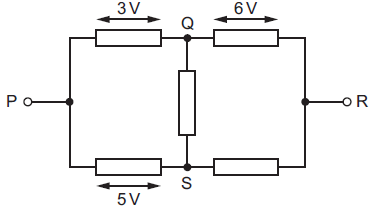Question 32
There is a current
from P to R in the resistor network shown.
The potential
difference (p.d.) between P and Q is 3 V.
The p.d. between Q and
R is 6 V.
The p.d. between P and
S is 5 V.
Which row in the table is correct?
Reference: Past Exam Paper – June 2016 Paper 11 Q35
Solution:
Answer:
A.
Current flows from P to R.
Recall that current cannot
flow in opposite directions in the same wire.
There are different paths
that the current could possibly flow.
Path 1: P to Q to R
Path 2: P to Q to S to R
Path 3: P to S to R
Path 4: P to S to Q to R
The p.d. between P and R
is constant. This means that the sum of p.d. in any of the paths should be the
same.
Let the p.d. between Q and
S be QS and the p.d. between S and R be SR.
Considering the different
paths,
Path 1: p.d between P and
R = 3 + 6 = 9 V
Path 2: p.d. between P and
R = 3 + QS + SR
The sum of p.d. in path 2
should also be 9 V as the p.d. between P and R is constant.
3 + QS + SR = 9
QS + SR = 9 – 3 = 6
QS + SR = 6 eq (1)
Path 3: p.d. between P and
R = 5 + SR = 9
SR = 9 – 5 = 4 V
Substituting SR = 4 V in
eq (1),
QS + 4 = 6
QS = 6 – 4 = 2 V
Path 4 may not be a
possible path as the sum of p.d. is different.



No comments:
Post a Comment
If it's a past exam question, do not include links to the paper. Only the reference.
Comments will only be published after moderation